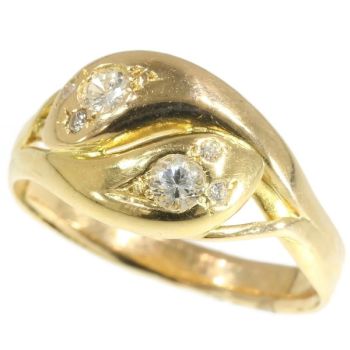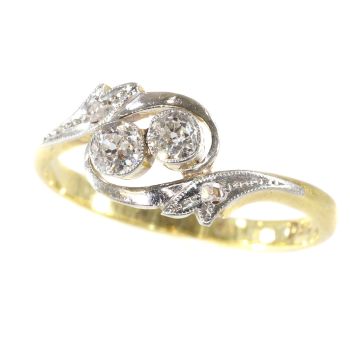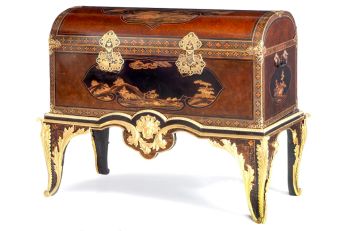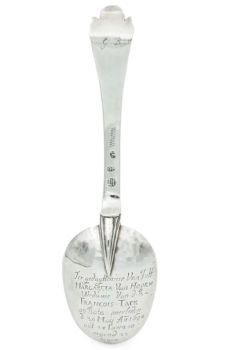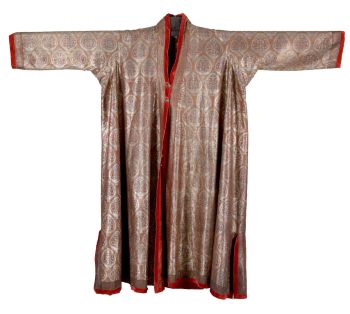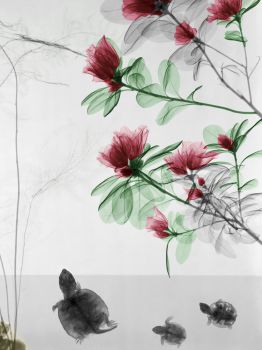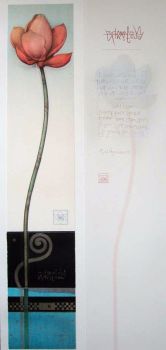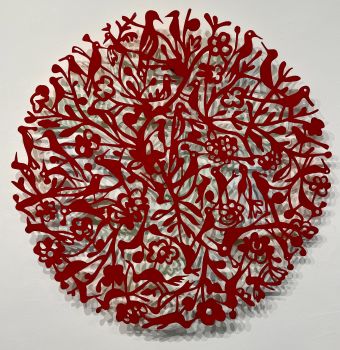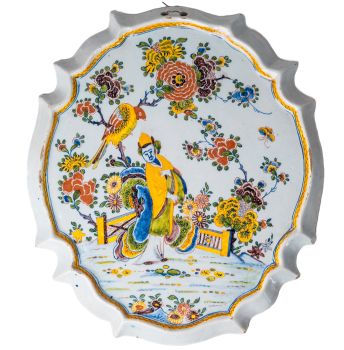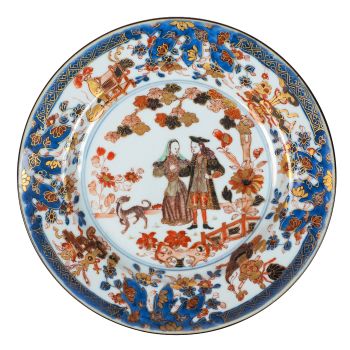Indian colonial inlaid work box, 18th century 1700 - 1750
Artista Desconocido
HuesoMaderaMarfilMetalLatón
33 ⨯ 48 ⨯ 12 cm
ConditionGood
€ 3.500
Verkoulen Oriental & European Antiques
- Sobre la obra de arteAn exotic (Anglo-)Indian work box made of rosewood and ebony with ivory inlaid floral motifs, 18th century, around 1700-1750, Vizagapatam, India.
Dimensions: 32,5 x 47,5 x 12 cm.
This larger document or work box is an example of typical early 18th century craftmanship influenced by the Europeans but also the Indian taste and culture. The brownish with darker veining rosewood is considered as a precious hardwood and perfect to withstand the warm and moistures climate of the Indian ocean region and Indonesian archipelago. The ivory is etched and filled with black lacquer to form a shade on the flower buds. The ‘scrolling vines’ created out of black leaves and stems of the flower are inlaid with ebony wood. The top lid had four studded floral rosettes, and the sides of the box have brass handles. The front is also provided with an elegant brass lock plate and a key. On the inside we can find several compartments to store writing materials.
Vizagapatam was a fundamental center for production of luxurious objects exported to Europe and other ports. It was a part of Madras Presidency (the administrative divisions of Madras, province of British India with St. George fort) from the 17th century till the independence in 1947. The first written reference to ivory inlayed furniture in Vizagapatam was made in 1756 by Major John Corneille, who noted that the area was known for the quality of its Chintz (processed fabric), which is “esteemed the best in India for the brightness of its colours”, and that "the place is likewise remarkable for its inlay work, and justly for they do it to the greatest perfection". The British East India Company had a textile factory in Vizagapatam from 1668. Eventually by 1768 the British gained control over the whole area. It was a tradition in Vizagapatam to manufacture furniture in Western style, using ivory etched with lacquer inlaid into wood. The decoration they used in Vizagapatam was inspired from the Mughal culture. Even though the British had control over Vizagapatam and other regions, objects produced in Vizagapatam during the 18th century were also made for company officials from Holland as wel as the European market.
Condition: Good, some wear to the inlay work.
For a similar example mounted on a later stand, see: Christie's 17 February 2016, Live auction 12033, lot nr. 267.
NOTE: Please note that the shipping time takes longer for this object, because the need of CITES-Documents for export! - Sobre el artista
Puede suceder que un artista o creador sea desconocido.
Algunas obras no deben determinarse por quién está hecho o por (un grupo de) artesanos. Algunos ejemplos son estatuas de la Antigüedad, muebles, espejos o firmas que no son claras o legibles, pero también algunas obras no están firmadas en absoluto.
También puedes encontrar la siguiente descripción:
•"Atribuido a …." En su opinión, probablemente una obra del artista, al menos en parte.
•“Estudio de….” o “Taller de” En su opinión, una obra ejecutada en el estudio o taller del artista, posiblemente bajo su supervisión
•“Círculo de…” En su opinión, una obra del período del artista que muestra su influencia, estrechamente asociado con el artista pero no necesariamente su alumno.
•"Estilo de …." o “Seguidor de…”. En su opinión, una obra ejecutada al estilo del artista pero no necesariamente por un alumno; puede ser contemporáneo o casi contemporáneo
•"Manera de …." En su opinión una obra al estilo del artista pero de fecha posterior
•"Después …." En su opinión, una copia (de cualquier fecha) de una obra del artista
•“Firmado…”, “Fechado…” o “Inscrito” En su opinión, la obra ha sido firmada/fechada/inscrita por el artista. La adición de un signo de interrogación indica un elemento de duda.
•“Con firma…”, “Con fecha…”, “Con inscripción…” o “Lleva firma/fecha/inscripción” en su opinión la firma/fecha/inscripción ha sido añadida por alguien que no es el artista
¿Está interesado en comprar esta obra de arte?
Artwork details
Related artworks
Artista Desconocido
A superb Indonesian royal gem-set gold overlaid silver betel box19th century
Precio a consultarZebregs & Röell - Fine Art - Antiques
1 - 4 / 12Artista Desconocido
A superb Indonesian royal gem-set gold overlaid silver betel box19th century
Precio a consultarZebregs & Röell - Fine Art - Antiques
Paulus Franciscus Kromjong
Flores frente a Arearea Aka (alegría) por Gauguin '20th century
Precio a consultarZebregs & Röell - Fine Art - Antiques
Joseph Savart
Four portraits of women of Guadeloupe1769
Precio a consultarZebregs & Röell - Fine Art - Antiques
Artista Desconocido
A Surinam-themed Amsterdam long-case clock1746 - 1756
Precio a consultarZebregs & Röell - Fine Art - Antiques
 curada por
curada porGallerease Magazine
Artista Desconocido
Japanese transition-style lacquer coffer 1640 - 1650
Precio a consultarZebregs & Röell - Fine Art - Antiques
Thea G.F. Eschauzier
Retrato de una niña javanesa1931
Precio a consultarZebregs & Röell - Fine Art - Antiques
Artista Desconocido
A silver spoon commemorating Juff’ Margareta van Hoorn1656 - 1694
Precio a consultarZebregs & Röell - Fine Art - Antiques
1 - 4 / 24Artista Desconocido
A Japanese bronze Hu flower vase, Edo / Meiji, 19th century19th century
Precio a consultarMenken Works of Art
Artista Desconocido
UN PEQUEÑO NETSUKE DE MARFIL DE UN HOLANDÉS CON UN TAMBOR1750 - 1800
Precio a consultarZebregs & Röell - Fine Art - Antiques
Artista Desconocido
EIGHT NEO-GOTHIC STAINED GLASS WINDOWS WITH SUSPENSION EYELET, 19th C, BELGIUM.1850 - 1900
Precio a consultarSpectandum Gallery
Artista Desconocido
UN NETSUKE DE MARFIL DE UN HOLANDÉS CON UNA COCKEREL18th century
Precio a consultarZebregs & Röell - Fine Art - Antiques
Artista Desconocido
The Stamford Raffles Secretaires.1800 - 1813
Precio a consultarZebregs & Röell - Fine Art - Antiques
Artista Desconocido
PAREJA DE ANTORCHAS O VELAS DE TECA DORADA Y LACADA INDONESIA18th century
Precio a consultarZebregs & Röell - Fine Art - Antiques
Artista Desconocido
UN NETSUKE MARINE MARFIL DE UN HOLANDÉS CON UN VENTILADOR CHINO18th century
Precio a consultarZebregs & Röell - Fine Art - Antiques
Artista Desconocido
UN RARO TELESCOPIO DE CUERO LACADO JAPONÉS GRANDE1750 - 1800
Precio a consultarZebregs & Röell - Fine Art - Antiques
Artista Desconocido
UN MODELO JAPONÉS DE UN NORIMONO, UN PALANQUÍN1650 - 1700
Precio a consultarZebregs & Röell - Fine Art - Antiques
1 - 4 / 24Johannes van Dreght
Antique Dutch still life flowers in vase1740 - 1800
Precio a consultarGallerease Selected
1 - 4 / 24Artista Desconocido
A Dutch colonial Indonesian betel box with gold mounts1750 - 1800
Precio a consultarZebregs & Röell - Fine Art - Antiques
Artista Desconocido
UNA COLECCIÓN DE CUATRO CAJAS BÍBLICAS DE MARFIL DE SRI LANKAN18th century
Precio a consultarZebregs & Röell - Fine Art - Antiques
Artista Desconocido
UN NETSUKE DE MARFIL DE UN HOLANDÉS CON UNA COCKEREL18th century
Precio a consultarZebregs & Röell - Fine Art - Antiques
Artista Desconocido
UN NETSUKE MARINE MARFIL DE UN HOLANDÉS CON UN VENTILADOR CHINO18th century
Precio a consultarZebregs & Röell - Fine Art - Antiques
Artista Desconocido
IMPORTANTE Y RARO PINTURA INDIA DE ESTILO DE COMPAÑÍA EN MARFIL QUE REPRESENTA UN DESFILE1850 - 1900
Precio a consultarZebregs & Röell - Fine Art - Antiques
 curada por
curada porDanny Bree
Artista Desconocido
UN PEQUEÑO NETSUKE DE MARFIL DE UN HOLANDÉS CON UN TAMBOR1750 - 1800
Precio a consultarZebregs & Röell - Fine Art - Antiques
Artista Desconocido
A gem-set ivory sculpture of an Ottoman sultan1700 - 1750
Precio a consultarZebregs & Röell - Fine Art - Antiques
Firm Erhard & Sohne, Schwäbisch Gmünd
Erhard und Söhne – Jugendstil intarsia klok – 1908 / 19091900 - 1909
Precio a consultarAntiques Emporium
1 - 4 / 24- 1 - 4 / 8









